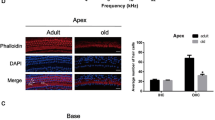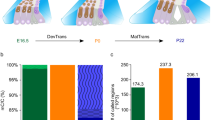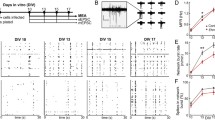Abstract
Histone methylation is an important epigenetic mark leading to changes in DNA accessibility and transcription. Here, we investigate immunoreactivity against the euchromatic histone-lysine N-methyltransferase EHMT2 and its catalyzed mono- and dimethylation marks at histone 3 lysine 9 (H3K9me1 and H3K9me2) during postnatal differentiation of the mouse central auditory system. In the brainstem, expression of EHMT2 was high in the first postnatal week and down-regulated thereafter. In contrast, immunoreactivity in the auditory cortex (AC) remained high during the first year of life. This difference might be related to distinct demands for adult plasticity. Analyses of two deaf mouse models, namely Cldn14 −/− and Cacna1d −/−, demonstrated that sound-driven or spontaneous activity had no influence on EHMT2 immunoreactivity. The methylation marks H3K9me1 and H3K9me2 were high throughout the auditory system up to 1 year. Young auditory neurons showed immunoreactivity against both methylations at similar intensities, whereas many mature neurons showed stronger labeling for either H3K9me1 or H3K9me2. These differences were only poorly correlated with cell types. To identify methyltransferases contributing to the persistent H3K9me1 and H3K9me2 marks in the adult brainstem, EHMT1 and the retinoblastoma-interacting zinc-finger protein RIZ1 were analyzed. Both were down-regulated during brainstem development, similar to EHMT2. Contrary to EHMT2, EHMT1 was also down-regulated in adult cortical areas. Together, our data reveal a marked difference in EHMT2 levels between mature brainstem and cortical areas and a decoupling between EHMT2 abundance and histone 3 lysine 9 methylations during brainstem differentiation. Furthermore, EHMT1 and EHMT2 are differentially expressed in cortical areas.













Similar content being viewed by others
References
Antignano F, Burrows K, Hughes MR, Han JM, Kron KJ, Penrod NM, Oudhoff MJ, Wang SKH, Min PH, Gold MJ, Chenery AL, Braam MJS, Fung TC, Rossi FMV, McNagny KM, Arrowsmith CH, Lupien M, Levings MK, Zaph C (2014) Methyltransferase G9A regulates T cell differentiation during murine intestinal inflammation. J Clin Invest 124:1945–1955. doi:10.1172/JCI69592
Barski A, Cuddapah S, Cui K, Roh T-Y, Schones DE, Wang Z, Wei G, Chepelev I, Zhao K (2007) High-resolution profiling of histone methylations in the human genome. Cell 129:823–837. doi:10.1016/j.cell.2007.05.009
Ben-Yosef T, Belyantseva IA, Saunders TL, Hughes ED, Kawamoto K, Itallie V, Christina M, Beyer LA, Halsey K, Gardner DJ, Wilcox ER, Rasmussen J, Anderson JM, Dolan DF, Forge A, Raphael Y, Camper SA, Friedman TB (2003) Claudin 14 knockout mice, a model for autosomal recessive deafness DFNB29, are deaf due to cochlear hair cell degeneration. Hum Mol Genet 12:2049–2061
Byvoet P, Shepherd GR, Hardin JM, Noland BJ (1972) The distribution and turnover of labeled methyl groups in histone fractions of cultured mammalian cells. Arch Biochem Biophys 148:558–567
Chen L, Li Z, Zwolinska AK, Smith MA, Cross B, Koomen J, Yuan Z-M, Jenuwein T, Marine J-C, Wright KL, Chen J (2010) MDM2 recruitment of lysine methyltransferases regulates p53 transcriptional output. EMBO J 29:2538–2552. doi:10.1038/emboj.2010.140
Congdon LM, Sims JK, Tuzon CT, Rice JC (2014) The PR-Set7 binding domain of Riz1 is required for the H4K20me1-H3K9me1 trans-tail “histone code” and Riz1 tumor suppressor function. Nucleic Acids Res 42:3580–3589. doi:10.1093/nar/gkt1377
Covington HE, Maze I, Sun H, Bomze HM, DeMaio KD, Wu EY, Dietz DM, Lobo MK, Ghose S, Mouzon E, Neve RL, Tamminga CA, Nestler EJ (2011) A role for repressive histone methylation in cocaine-induced vulnerability to stress. Neuron 71:656–670. doi:10.1016/j.neuron.2011.06.007
Dillon SC, Zhang X, Trievel RC, Cheng X (2005) The SET-domain protein superfamily: protein lysine methyltransferases. Genome Biol 6:227. doi:10.1186/gb-2005-6-8-227
Ding N, Zhou H, Esteve P-O, Chin HG, Kim S, Xu X, Joseph SM, Friez MJ, Schwartz CE, Pradhan S, Boyer TG (2008) Mediator links epigenetic silencing of neuronal gene expression with x-linked mental retardation. Mol Cell 31:347–359. doi:10.1016/j.molcel.2008.05.023
Ebbers L, Satheesh SV, Janz K, Ruttiger L, Blosa M, Hofmann F, Morawski M, Griesemer D, Knipper M, Friauf E, Nothwang HG (2015) L-type calcium channel Cav1.2 is required for maintenance of auditory brainstem nuclei. J Biol Chem 290:23692–23710. doi:10.1074/jbc.M115.672675
Ehmann H, Hartwich H, Salzig C, Hartmann N, Clément-Ziza M, Ushakov K, Avraham KB, Bininda-Emonds ORP, Hartmann AK, Lang P, Friauf E, Nothwang HG (2013) Time-dependent gene expression analysis of the developing superior olivary complex. J Biol Chem 288:25865–25879. doi:10.1074/jbc.M113.490508
Friauf E (2004) Developmental changes and cellular plasticity in the superior olivary complex. In: Parks TN, Rubel EW, Fay RR, Popper AN (eds) Plasticity of the auditory system. Springer, New York, pp 49–95
Friauf E, Fischer AU, Fuhr MF (2015) Synaptic plasticity in the auditory system: a review. Cell Tissue Res 361:177–213. doi:10.1007/s00441-015-2176-x
Fujiyama T, Yamada M, Terao M, Terashima T, Hioki H, Inoue YU, Inoue T, Masuyama N, Obata K, Yanagawa Y, Kawaguchi Y, Nabeshima Y-I, Hoshino M (2009) Inhibitory and excitatory subtypes ofcochlear nucleus neurons are defined by distinct bHLH transcription factors, Ptf1a and Atoh1. Development 136:2049–2058. doi:10.1242/dev.033480
Goldberg AD, Allis CD, Bernstein E (2007) Epigenetics: a landscape takes shape. Cell 128:635–638. doi:10.1016/j.cell.2007.02.006
Gupta-Agarwal S, Franklin AV, Deramus T, Wheelock M, Davis RL, McMahon LL, Lubin FD (2012) G9a/GLP histone lysine dimethyltransferase complex activity in the hippocampus and the entorhinal cortex is required for gene activation and silencing during memory consolidation. J Neurosci 32:5440–5453. doi:10.1523/JNEUROSCI.0147-12.2012
Harris JA, Hardie NA, Bermingham-McDonogh O, Rubel EW (2005) Gene expression differences over a critical period of afferent-dependent neuron survival in the mouse auditory brainstem. J Comp Neurol 493:460–474
Harris JA, Iguchi F, Seidl AH, Lurie DI, Rubel EW (2008) Afferent deprivation elicits a transcriptional response associated with neuronal survival after a critical period in the mouse cochlear nucleus. J Neurosci 28:10990–11002
Hirtz JJ, Boesen M, Braun N, Deitmer JW, Kramer F, Lohr C, Muller B, Nothwang HG, Striessnig J, Lohrke S, Friauf E (2011) Cav1.3 calcium channels are required for normal development of the auditory brainstem. J Neurosci 31:8280–8294
Hirtz JJ, Braun N, Griesemer D, Hannes C, Janz K, Lohrke S, Muller B, Friauf E (2012) Synaptic refinement of an inhibitory topographic map in the auditory brainstem requires functional Cav1.3 calcium channels. J Neurosci 32:14602–14616
Holt AG, Asako M, Lomax CA, MacDonald JW, Tong L, Lomax MI, Altschuler RA (2005) Deafness-related plasticity in the inferior colliculus: gene expression profiling following removal of peripheral activity. J Neurochem 93:1069–1086
Kandler K, Clause A, Noh J (2009) Tonotopic reorganization of developing auditory brainstem circuits. Nat Neurosci 12:711–717
Kawaguchi Y, Cooper B, Gannon M, Ray M, Macdonald RJ, Wright CVE (2002) The role of the transcriptional regulator Ptf1a in converting intestinal to pancreatic progenitors. Nat Genet 32:128–134. doi:10.1038/ng959
Kleefstra T, Smidt M, Banning MJG, Oudakker AR, Esch H van, Brouwer APM de, Nillesen W, Sistermans EA, Hamel BCJ, Bruijn D de, Fryns J-P, Yntema HG, Brunner HG, Vries BBA de, Bokhoven H van (2005) Disruption of the gene euchromatin histone methyl transferase1 (Eu-HMTase1) is associated with the 9q34 subtelomeric deletion syndrome. J Med Genet 42:299–306. doi:10.1136/jmg.2004.028464
Kramer JM (2016) Regulation of cell differentiation and function by the euchromatin histone methyltransferases G9a and GLP. Biochem Cell Biol 94:26-32. doi:10.1139/bcb-2015-0017
Kramer JM, Kochinke K, Oortveld MAW, Marks H, Kramer D, Jong EK de, Asztalos Z, Westwood JT, Stunnenberg HG, Sokolowski MB, Keleman K, Zhou H, Bokhoven H van, Schenck A (2011) Epigenetic regulation of learning and memory by Drosophila EHMT/G9a. PLoS Biol 9:e1000569. doi:10.1371/journal.pbio.1000569
Layman WS, Zuo J (2014) Epigenetic regulation in the inner ear and its potential roles in development, protection, and regeneration. Front Cell Neurosci 8:446. doi:10.3389/fncel.2014.00446
Leung DC, Dong KB, Maksakova IA, Goyal P, Appanah R, Lee S, Tachibana M, Shinkai Y, Lehnertz B, Mager DL, Rossi F, Lorincz MC (2011) Lysine methyltransferase G9a is required for de novo DNA methylation and the establishment, but not the maintenance, of proviral silencing. Proc Natl Acad Sci U S A 108:5718–5723. doi:10.1073/pnas.1014660108
Ling BMT, Bharathy N, Chung T-K, Kok WK, Li S, Tan YH, Rao VK, Gopinadhan S, Sartorelli V, Walsh MJ, Taneja R (2012) Lysine methyltransferase G9a methylates the transcription factor MyoD and regulates skeletal muscle differentiation. Proc Natl Acad Sci U S A 109:841–846. doi:10.1073/pnas.1111628109
Lister R, Mukamel EA, Nery JR, Urich M, Puddifoot CA, Johnson ND, Lucero J, Huang Y, Dwork AJ, Schultz MD, Yu M, Tonti-Filippini J, Heyn H, Hu S, Wu JC, Rao A, Esteller M, He C, Haghighi FG, Sejnowski TJ, Behrens MM, Ecker JR (2013) Global epigenomic reconfiguration during mammalian brain development. Science 341:1237905. doi:10.1126/science.1237905
Lu Z, Tian Y, Salwen HR, Chlenski A, Godley LA, Raj JU, Yang Q (2013) Histone-lysine methyltransferase EHMT2 is involved in proliferation, apoptosis, cell invasion, and DNA methylation of human neuroblastoma cells. Anti-Cancer Drugs 24:484–493. doi:10.1097/CAD.0b013e32835ffdbb
Madisen L, Zwingman TA, Sunkin SM, Oh SW, Zariwala HA, Gu H, Ng LL, Palmiter RD, Hawrylycz MJ, Jones AR, Lein ES, Zeng H (2010) A robust and high-throughput Cre reporting and characterization system for the whole mouse brain. Nat Neurosci 13:133–140. doi:10.1038/nn.2467
Maze I, Covington HE, Dietz DM, LaPlant Q, Renthal W, Russo SJ, Mechanic M, Mouzon E, Neve RL, Haggarty SJ, Ren Y, Sampath SC, Hurd YL, Greengard P, Tarakhovsky A, Schaefer A, Nestler EJ (2010) Essential role of the histone methyltransferase G9a in cocaine-induced plasticity. Science 327:213–216. doi:10.1126/science.1179438
Mikaelian D, Ruben RJ (1965) Development of hearing in the normal Cba-J mouse: correlation of physiological observations with behavioral responses and with cochlear anatomy. Acta Otolaryngol 59:451–461. doi:10.3109/00016486509124579
Mo A, Mukamel EA, Davis FP, Luo C, Henry GL, Picard S, Urich MA, Nery JR, Sejnowski TJ, Lister R, Eddy SR, Ecker JR, Nathans J (2015) Epigenomic signatures of neuronal diversity in the mammalian brain. Neuron 86:1369–1384. doi:10.1016/j.neuron.2015.05.018
Mostafapour SP, Cochran SL, Del Puerto NM, Rubel EW (2000) Patterns of cell death in mouse anteroventral cochlear nucleus neurons after unilateral cochlea removal. J Comp Neurol 426:561–571
Mutai H, Miya F, Fujii M, Tsunoda T, Matsunaga T (2015) Attenuation of progressive hearing loss in DBA/2J mice by reagents that affect epigenetic modifications is associated with up-regulation of the zinc importer Zip4. PLoS ONE 10:e0124301. doi:10.1371/journal.pone.0124301
Nothwang HG, Ebbers L, Schluter T, Willaredt MA (2015) The emerging framework of mammalian auditory hindbrain development. Cell Tissue Res 361:33–48. doi:10.1007/s00441-014-2110-7
Oertel D, Young ED (2004) What’s a cerebellar circuit doing in the auditory system? Trends Neurosci 27:104–110
Ogawa H, Ishiguro K-I, Gaubatz S, Livingston DM, Nakatani Y (2002) A complex with chromatin modifiers that occupies E2F- and Myc-responsive genes in G0 cells. Science 296:1132–1136. doi:10.1126/science.1069861
Pfaffl MW (2001) A new mathematical model for relative quantification in real-time RT-PCR. Nucleic Acids Res 29:e45
Platzer J, Engel J, Schrott-Fischer A, Stephan K, Bova S, Chen H, Zheng H, Striessnig J (2000) Congenital deafness and sinoatrial node dysfunction in mice lacking class D L-type Ca2+ channels. Cell 102:89–97
Rao RC, Tchedre KT, Malik MTA, Coleman N, Fang Y, Marquez VE, Chen DF (2010) Dynamic patterns of histone lysine methylation in the developing retina. Invest Ophthalmol Vis Sci 51:6784–6792. doi:10.1167/iovs.09-4730
Roopra A, Qazi R, Schoenike B, Daley TJ, Morrison JF (2004) Localized domains of G9a-mediated histone methylation are required for silencing of neuronal genes. Mol Cell 14:727–738. doi:10.1016/j.molcel.2004.05.026
Rubel EW, Parks TN, Zirpel L (2004) Assembling, connecting and maintaining the cochlear nucleus. In: Parks TN, Rubel EW, Fay RR, Popper AN (eds) Plasticity of the auditory system. Springer, New York, pp 9–48
Satheesh SV, Kunert K, Ruttiger L, Zuccotti A, Schonig K, Friauf E, Knipper M, Bartsch D, Nothwang HG (2012) Retrocochlear function of the peripheral deafness gene Cacna1d. Hum Mol Genet 21:3896–3909
Saul SM, Brzezinski JA, Altschuler RA, Shore SE, Rudolph DD, Kabara LL, Halsey KE, Hufnagel RB, Zhou J, Dolan DF, Glaser T (2008) Math5 expression and function in the central auditory system. Mol Cell Neurosci 37:153–169
Schaefer A, Sampath SC, Intrator A, Min A, Gertler TS, Surmeier DJ, Tarakhovsky A, Greengard P (2009) Control of cognition and adaptive behavior by the GLP/G9a epigenetic suppressor complex. Neuron 64:678–691. doi:10.1016/j.neuron.2009.11.019
Sharma A, Klein SS, Barboza L, Lohdi N, Toth M (2016) Principles governing DNA methylation during neuronal lineage and subtype specification. J Neurosci 36:1711–1722. doi:10.1523/JNEUROSCI.4037-15.2016
Shi Y (2007) Histone lysine demethylases: emerging roles in development, physiology and disease. Nat Rev Genet 8:829–833. doi:10.1038/nrg2218
Shinkai Y, Tachibana M (2011) H3K9 methyltransferase G9a and the related molecule GLP. Genes Dev 25:781–788. doi:10.1101/gad.2027411
Sun H, Maze I, Dietz DM, Scobie KN, Kennedy PJ, Damez-Werno D, Neve RL, Zachariou V, Shen L, Nestler EJ (2012) Morphine epigenomically regulates behavior through alterations in histone H3 lysine 9 dimethylation in the nucleus accumbens. J Neurosci 32:17454–17464. doi:10.1523/JNEUROSCI.1357-12.2012
Sweatt JD (2013) The emerging field of neuroepigenetics. Neuron 80:624–632. doi:10.1016/j.neuron.2013.10.023
Tachibana M, Sugimoto K, Nozaki M, Ueda J, Ohta T, Ohki M, Fukuda M, Takeda N, Niida H, Kato H, Shinkai Y (2002) G9a histone methyltransferase plays a dominant role in euchromatic histone H3 lysine 9 methylation and is essential for early embryogenesis. Genes Dev 16:1779–1791. doi:10.1101/gad.989402
Tachibana M, Ueda J, Fukuda M, Takeda N, Ohta T, Iwanari H, Sakihama T, Kodama T, Hamakubo T, Shinkai Y (2005) Histone methyltransferases G9a and GLP form heteromeric complexes and are both crucial for methylation of euchromatin at H3-K9. Genes Dev 19:815–826. doi:10.1101/gad.1284005
Waddington CH (1942) The epigenotype. Endeavour 1:18–20
Wang HC, Bergles DE (2015) Spontaneous activity in the developing auditory system. Cell Tissue Res 361:65–75. doi:10.1007/s00441-014-2007-5
Wang L, Xu S, Lee J-E, Baldridge A, Grullon S, Peng W, Ge K (2013) Histone H3K9 methyltransferase G9a represses PPARgamma expression and adipogenesis. EMBO J 32:45–59. doi:10.1038/emboj.2012.306
Weiss T, Hergeth S, Zeissler U, Izzo A, Tropberger P, Zee BM, Dundr M, Garcia BA, Daujat S, Schneider R (2010) Histone H1 variant-specific lysine methylation by G9a/KMT1C and Glp1/KMT1D. Epigenetics Chromatin 3:7. doi:10.1186/1756-8935-3-7
Willaredt MA, Ebbers L, Nothwang HG (2014) Central auditory function of deafness genes. Hear Res 312:9–20. doi:10.1016/j.heares.2014.02.004
Yang Z, Ding K, Pan L, Deng M, Gan L (2003) Math5 determines the competence state of retinal ganglion cell progenitors. Dev Biol 264:240–254
Yao B, Jin P (2014) Unlocking epigenetic codes in neurogenesis. Genes Dev 28:1253–1271. doi:10.1101/gad.241547.114
Yu W-M, Goodrich LV (2014) Morphological and physiological development of auditory synapses. Hear Res 311:3–16. doi:10.1016/j.heares.2014.01.007
Yu H, Lin Q, Wang Y, He Y, Fu S, Jiang H, Yu Y, Sun S, Chen Y, Shou J, Li H (2013) Inhibition of H3K9 methyltransferases G9a/GLP prevents ototoxicity and ongoing hair cell death. Cell Death Dis 4:e506. doi:10.1038/cddis.2013.28
Zhang X, Wen H, Shi X (2012) Lysine methylation: beyond histones. Acta Biochim Biophys Sin 44:14–27. doi:10.1093/abbs/gmr100
Acknowledgments
We thank Martina Reents for expert help with genotyping and Dr. Gan and Dr. Wright for allowing use of the Ptf1a:: Cre and Atoh7:: Cre driver lines.
Author information
Authors and Affiliations
Corresponding author
Additional information
This work was supported by the DFG priority program 1608 “Ultrafast and temporally precise information processing: normal and dysfunctional hearing” No428/10-1, No428/7-1 and the Cluster of Excellence Hearing4All to H.G.N.
Rights and permissions
About this article
Cite this article
Ebbers, L., Runge, K. & Nothwang, H.G. Differential patterns of histone methylase EHMT2 and its catalyzed histone modifications H3K9me1 and H3K9me2 during maturation of central auditory system. Cell Tissue Res 365, 247–264 (2016). https://doi.org/10.1007/s00441-016-2401-2
Received:
Accepted:
Published:
Issue Date:
DOI: https://doi.org/10.1007/s00441-016-2401-2




